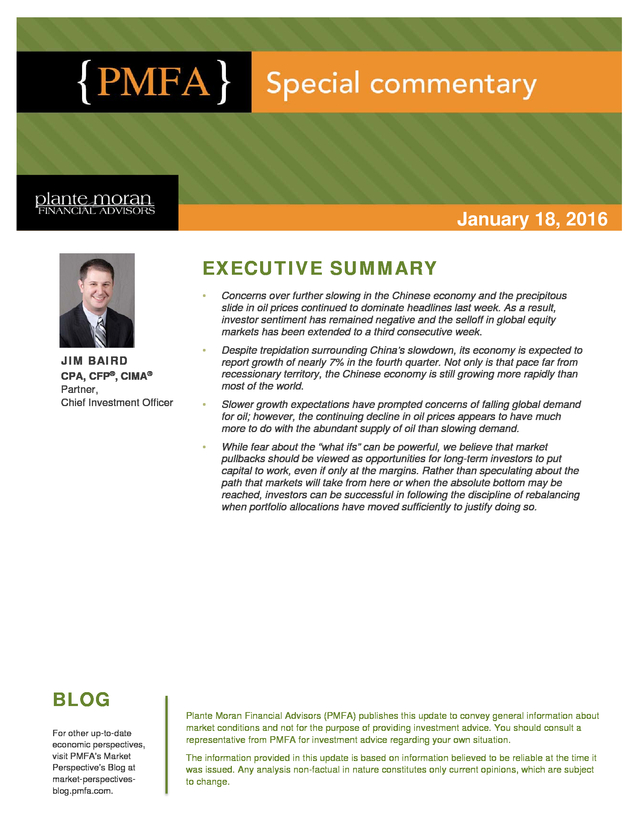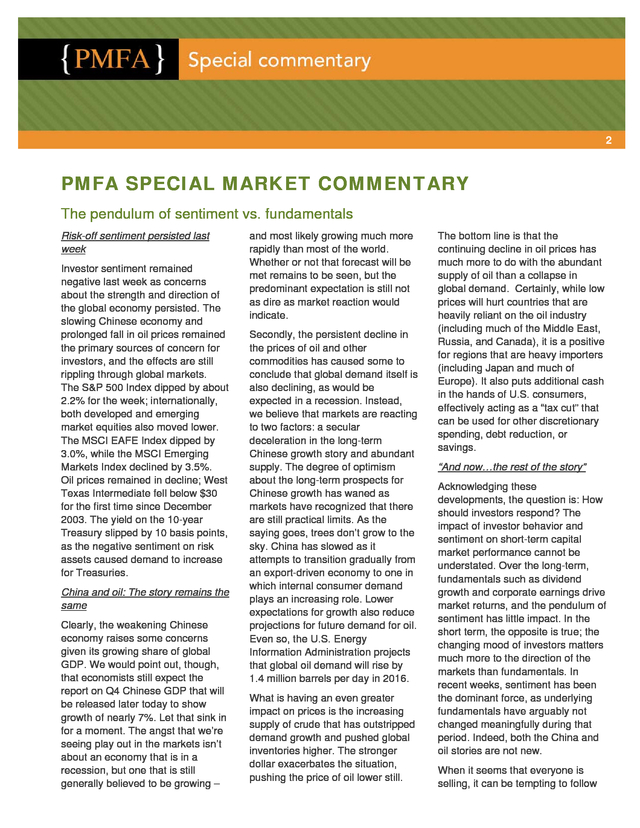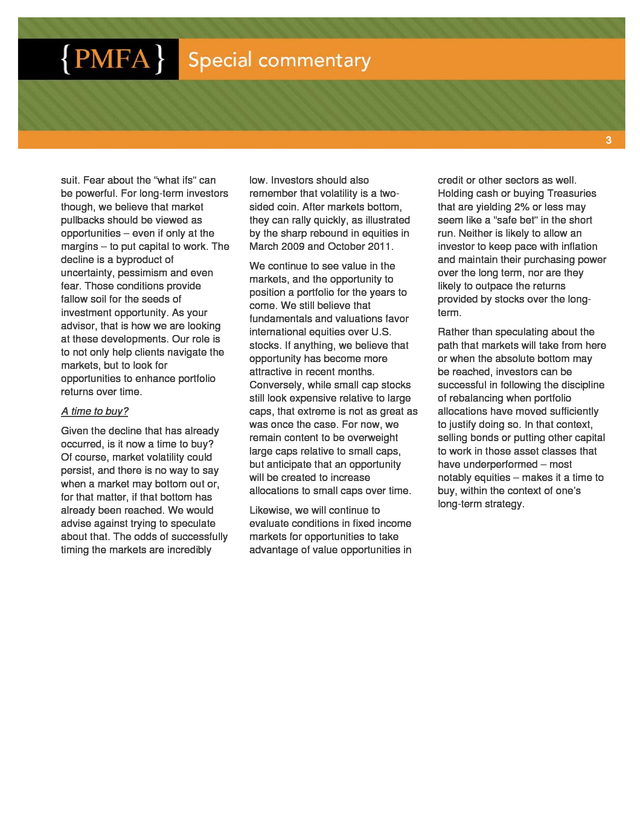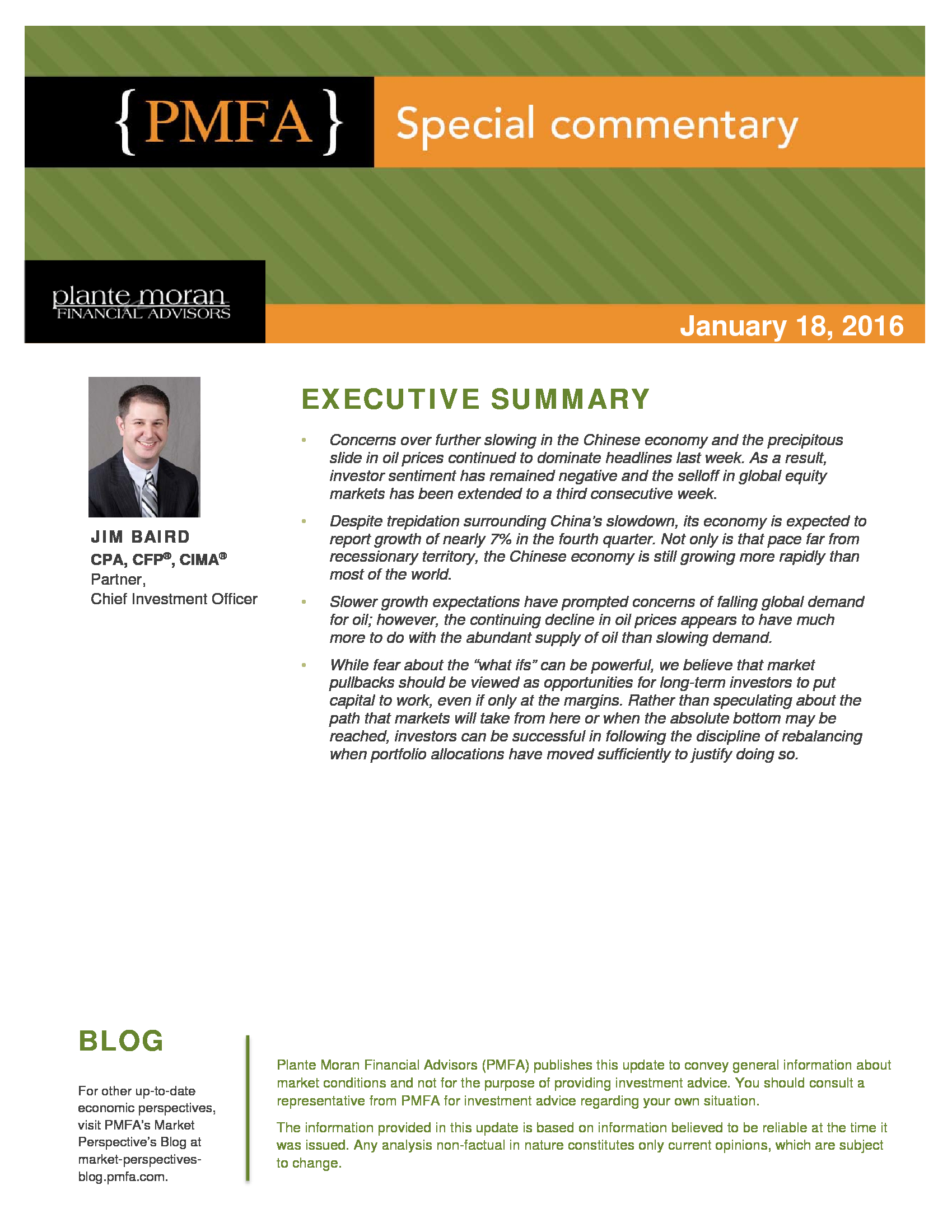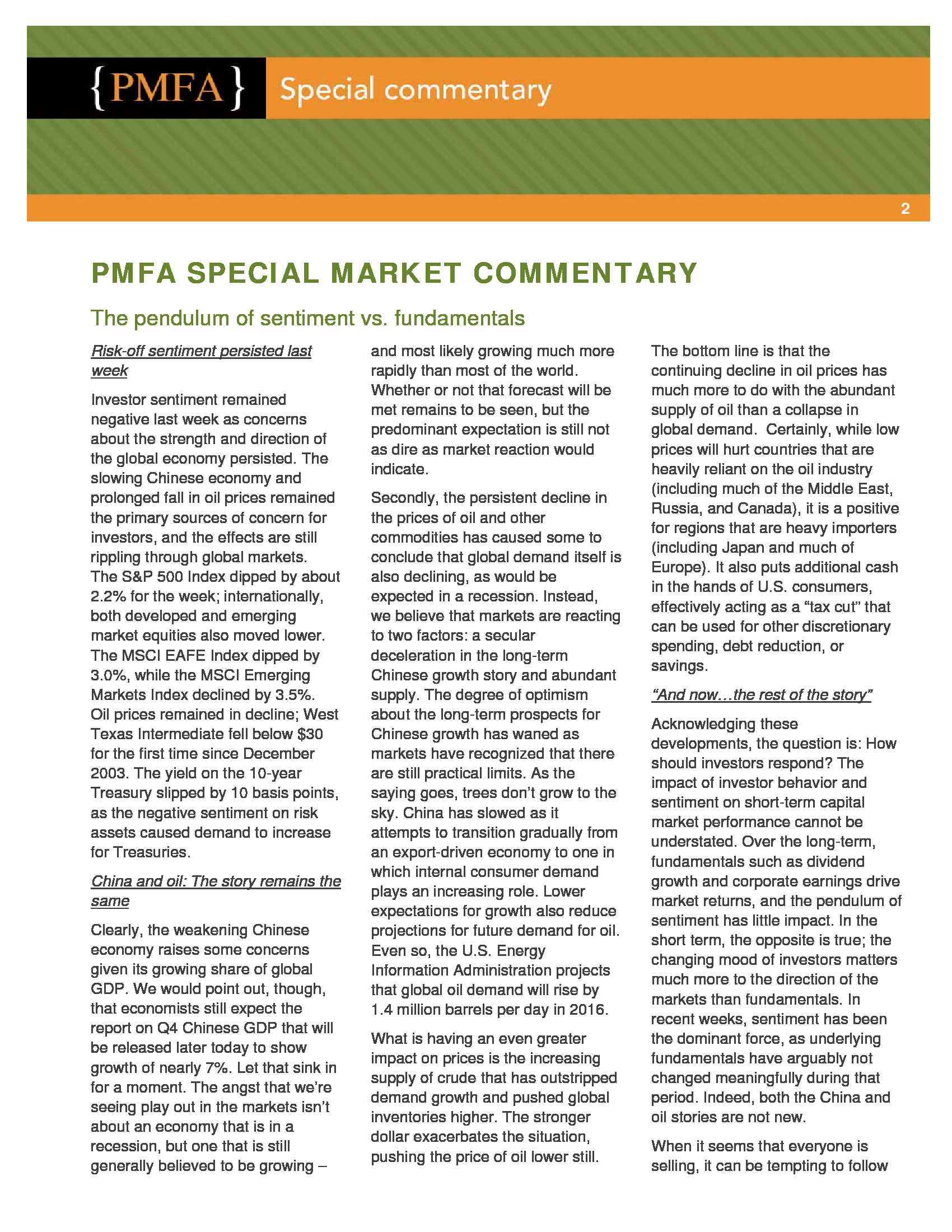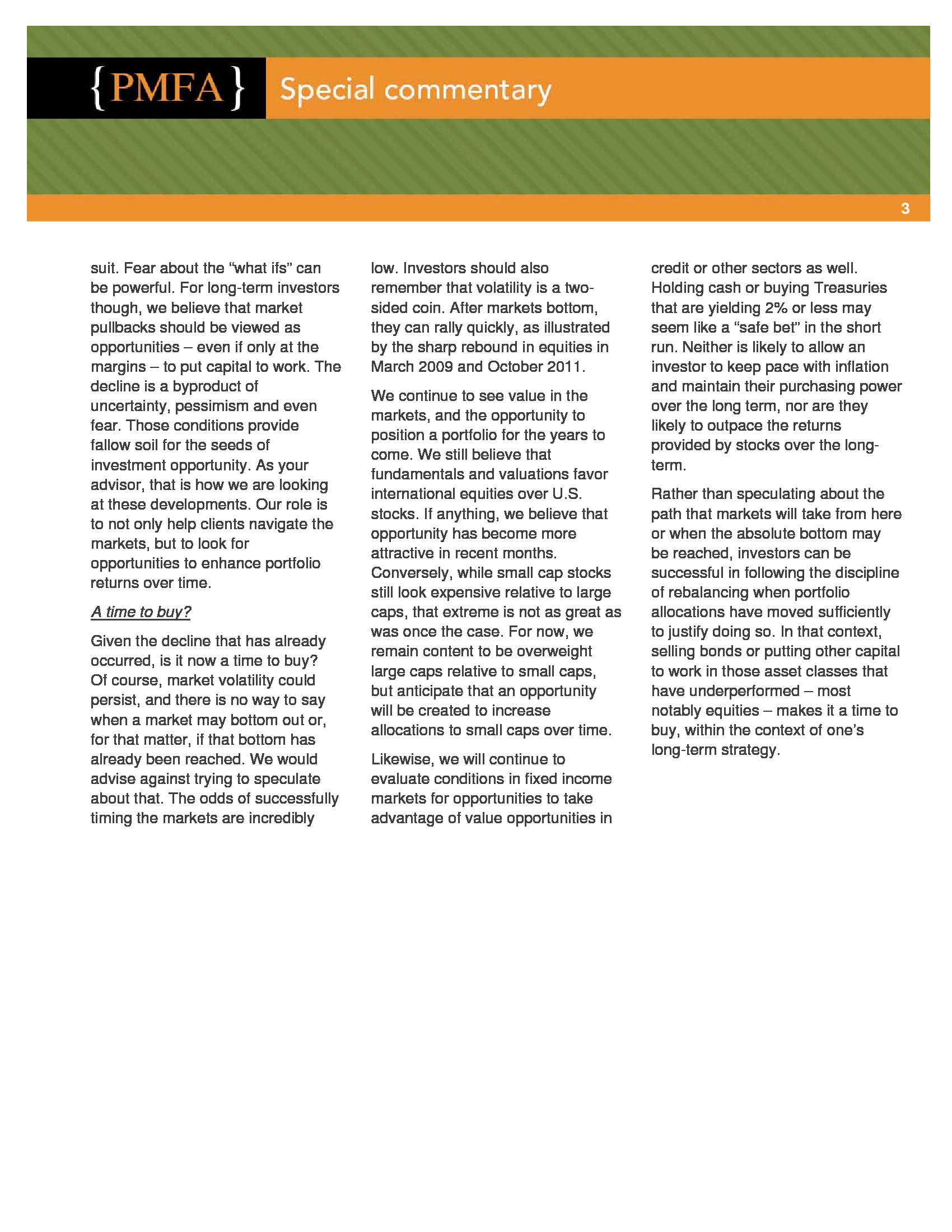Description
January 18, 2016
EXECUTIVE SUMMARY
•
CPA, CFP®, CIMA®
Partner,
Chief Investment Officer
•
Despite trepidation surrounding China’s slowdown, its economy is expected to
report growth of nearly 7% in the fourth quarter. Not only is that pace far from
recessionary territory, the Chinese economy is still growing more rapidly than
most of the world.
•
Slower growth expectations have prompted concerns of falling global demand
for oil; however, the continuing decline in oil prices appears to have much
more to do with the abundant supply of oil than slowing demand.
•
JIM BAIRD
Concerns over further slowing in the Chinese economy and the precipitous
slide in oil prices continued to dominate headlines last week. As a result,
investor sentiment has remained negative and the selloff in global equity
markets has been extended to a third consecutive week.
While fear about the “what ifs” can be powerful, we believe that market
pullbacks should be viewed as opportunities for long-term investors to put
capital to work, even if only at the margins. Rather than speculating about the
path that markets will take from here or when the absolute bottom may be
reached, investors can be successful in following the discipline of rebalancing
when portfolio allocations have moved sufficiently to justify doing so.
BLOG
For other up-to-date
economic perspectives,
visit PMFA’s Market
Perspective’s Blog at
market-perspectivesblog.pmfa.com.
Plante Moran Financial Advisors (PMFA) publishes this update to convey general information about
market conditions and not for the purpose of providing investment advice.
You should consult a representative from PMFA for investment advice regarding your own situation. The information provided in this update is based on information believed to be reliable at the time it was issued. Any analysis non-factual in nature constitutes only current opinions, which are subject to change. . 2 PMFA SPECIAL MARKET COMMENTARY The pendulum of sentiment vs. fundamentals Risk-off sentiment persisted last week Investor sentiment remained negative last week as concerns about the strength and direction of the global economy persisted. The slowing Chinese economy and prolonged fall in oil prices remained the primary sources of concern for investors, and the effects are still rippling through global markets. The S&P 500 Index dipped by about 2.2% for the week; internationally, both developed and emerging market equities also moved lower. The MSCI EAFE Index dipped by 3.0%, while the MSCI Emerging Markets Index declined by 3.5%. Oil prices remained in decline; West Texas Intermediate fell below $30 for the first time since December 2003. The yield on the 10-year Treasury slipped by 10 basis points, as the negative sentiment on risk assets caused demand to increase for Treasuries. China and oil: The story remains the same Clearly, the weakening Chinese economy raises some concerns given its growing share of global GDP.
We would point out, though, that economists still expect the report on Q4 Chinese GDP that will be released later today to show growth of nearly 7%. Let that sink in for a moment. The angst that we’re seeing play out in the markets isn’t about an economy that is in a recession, but one that is still generally believed to be growing – and most likely growing much more rapidly than most of the world. Whether or not that forecast will be met remains to be seen, but the predominant expectation is still not as dire as market reaction would indicate. Secondly, the persistent decline in the prices of oil and other commodities has caused some to conclude that global demand itself is also declining, as would be expected in a recession.
Instead, we believe that markets are reacting to two factors: a secular deceleration in the long-term Chinese growth story and abundant supply. The degree of optimism about the long-term prospects for Chinese growth has waned as markets have recognized that there are still practical limits. As the saying goes, trees don’t grow to the sky.
China has slowed as it attempts to transition gradually from an export-driven economy to one in which internal consumer demand plays an increasing role. Lower expectations for growth also reduce projections for future demand for oil. Even so, the U.S. Energy Information Administration projects that global oil demand will rise by 1.4 million barrels per day in 2016. What is having an even greater impact on prices is the increasing supply of crude that has outstripped demand growth and pushed global inventories higher.
The stronger dollar exacerbates the situation, pushing the price of oil lower still. The bottom line is that the continuing decline in oil prices has much more to do with the abundant supply of oil than a collapse in global demand. Certainly, while low prices will hurt countries that are heavily reliant on the oil industry (including much of the Middle East, Russia, and Canada), it is a positive for regions that are heavy importers (including Japan and much of Europe). It also puts additional cash in the hands of U.S.
consumers, effectively acting as a “tax cut” that can be used for other discretionary spending, debt reduction, or savings. “And now…the rest of the story” Acknowledging these developments, the question is: How should investors respond? The impact of investor behavior and sentiment on short-term capital market performance cannot be understated. Over the long-term, fundamentals such as dividend growth and corporate earnings drive market returns, and the pendulum of sentiment has little impact. In the short term, the opposite is true; the changing mood of investors matters much more to the direction of the markets than fundamentals.
In recent weeks, sentiment has been the dominant force, as underlying fundamentals have arguably not changed meaningfully during that period. Indeed, both the China and oil stories are not new. When it seems that everyone is selling, it can be tempting to follow . 3 suit. Fear about the “what ifs” can be powerful. For long-term investors though, we believe that market pullbacks should be viewed as opportunities – even if only at the margins – to put capital to work. The decline is a byproduct of uncertainty, pessimism and even fear.
Those conditions provide fallow soil for the seeds of investment opportunity. As your advisor, that is how we are looking at these developments. Our role is to not only help clients navigate the markets, but to look for opportunities to enhance portfolio returns over time. A time to buy? Given the decline that has already occurred, is it now a time to buy? Of course, market volatility could persist, and there is no way to say when a market may bottom out or, for that matter, if that bottom has already been reached.
We would advise against trying to speculate about that. The odds of successfully timing the markets are incredibly low. Investors should also remember that volatility is a twosided coin.
After markets bottom, they can rally quickly, as illustrated by the sharp rebound in equities in March 2009 and October 2011. We continue to see value in the markets, and the opportunity to position a portfolio for the years to come. We still believe that fundamentals and valuations favor international equities over U.S. stocks. If anything, we believe that opportunity has become more attractive in recent months. Conversely, while small cap stocks still look expensive relative to large caps, that extreme is not as great as was once the case.
For now, we remain content to be overweight large caps relative to small caps, but anticipate that an opportunity will be created to increase allocations to small caps over time. Likewise, we will continue to evaluate conditions in fixed income markets for opportunities to take advantage of value opportunities in credit or other sectors as well. Holding cash or buying Treasuries that are yielding 2% or less may seem like a “safe bet” in the short run. Neither is likely to allow an investor to keep pace with inflation and maintain their purchasing power over the long term, nor are they likely to outpace the returns provided by stocks over the longterm. Rather than speculating about the path that markets will take from here or when the absolute bottom may be reached, investors can be successful in following the discipline of rebalancing when portfolio allocations have moved sufficiently to justify doing so. In that context, selling bonds or putting other capital to work in those asset classes that have underperformed – most notably equities – makes it a time to buy, within the context of one’s long-term strategy. .
You should consult a representative from PMFA for investment advice regarding your own situation. The information provided in this update is based on information believed to be reliable at the time it was issued. Any analysis non-factual in nature constitutes only current opinions, which are subject to change. . 2 PMFA SPECIAL MARKET COMMENTARY The pendulum of sentiment vs. fundamentals Risk-off sentiment persisted last week Investor sentiment remained negative last week as concerns about the strength and direction of the global economy persisted. The slowing Chinese economy and prolonged fall in oil prices remained the primary sources of concern for investors, and the effects are still rippling through global markets. The S&P 500 Index dipped by about 2.2% for the week; internationally, both developed and emerging market equities also moved lower. The MSCI EAFE Index dipped by 3.0%, while the MSCI Emerging Markets Index declined by 3.5%. Oil prices remained in decline; West Texas Intermediate fell below $30 for the first time since December 2003. The yield on the 10-year Treasury slipped by 10 basis points, as the negative sentiment on risk assets caused demand to increase for Treasuries. China and oil: The story remains the same Clearly, the weakening Chinese economy raises some concerns given its growing share of global GDP.
We would point out, though, that economists still expect the report on Q4 Chinese GDP that will be released later today to show growth of nearly 7%. Let that sink in for a moment. The angst that we’re seeing play out in the markets isn’t about an economy that is in a recession, but one that is still generally believed to be growing – and most likely growing much more rapidly than most of the world. Whether or not that forecast will be met remains to be seen, but the predominant expectation is still not as dire as market reaction would indicate. Secondly, the persistent decline in the prices of oil and other commodities has caused some to conclude that global demand itself is also declining, as would be expected in a recession.
Instead, we believe that markets are reacting to two factors: a secular deceleration in the long-term Chinese growth story and abundant supply. The degree of optimism about the long-term prospects for Chinese growth has waned as markets have recognized that there are still practical limits. As the saying goes, trees don’t grow to the sky.
China has slowed as it attempts to transition gradually from an export-driven economy to one in which internal consumer demand plays an increasing role. Lower expectations for growth also reduce projections for future demand for oil. Even so, the U.S. Energy Information Administration projects that global oil demand will rise by 1.4 million barrels per day in 2016. What is having an even greater impact on prices is the increasing supply of crude that has outstripped demand growth and pushed global inventories higher.
The stronger dollar exacerbates the situation, pushing the price of oil lower still. The bottom line is that the continuing decline in oil prices has much more to do with the abundant supply of oil than a collapse in global demand. Certainly, while low prices will hurt countries that are heavily reliant on the oil industry (including much of the Middle East, Russia, and Canada), it is a positive for regions that are heavy importers (including Japan and much of Europe). It also puts additional cash in the hands of U.S.
consumers, effectively acting as a “tax cut” that can be used for other discretionary spending, debt reduction, or savings. “And now…the rest of the story” Acknowledging these developments, the question is: How should investors respond? The impact of investor behavior and sentiment on short-term capital market performance cannot be understated. Over the long-term, fundamentals such as dividend growth and corporate earnings drive market returns, and the pendulum of sentiment has little impact. In the short term, the opposite is true; the changing mood of investors matters much more to the direction of the markets than fundamentals.
In recent weeks, sentiment has been the dominant force, as underlying fundamentals have arguably not changed meaningfully during that period. Indeed, both the China and oil stories are not new. When it seems that everyone is selling, it can be tempting to follow . 3 suit. Fear about the “what ifs” can be powerful. For long-term investors though, we believe that market pullbacks should be viewed as opportunities – even if only at the margins – to put capital to work. The decline is a byproduct of uncertainty, pessimism and even fear.
Those conditions provide fallow soil for the seeds of investment opportunity. As your advisor, that is how we are looking at these developments. Our role is to not only help clients navigate the markets, but to look for opportunities to enhance portfolio returns over time. A time to buy? Given the decline that has already occurred, is it now a time to buy? Of course, market volatility could persist, and there is no way to say when a market may bottom out or, for that matter, if that bottom has already been reached.
We would advise against trying to speculate about that. The odds of successfully timing the markets are incredibly low. Investors should also remember that volatility is a twosided coin.
After markets bottom, they can rally quickly, as illustrated by the sharp rebound in equities in March 2009 and October 2011. We continue to see value in the markets, and the opportunity to position a portfolio for the years to come. We still believe that fundamentals and valuations favor international equities over U.S. stocks. If anything, we believe that opportunity has become more attractive in recent months. Conversely, while small cap stocks still look expensive relative to large caps, that extreme is not as great as was once the case.
For now, we remain content to be overweight large caps relative to small caps, but anticipate that an opportunity will be created to increase allocations to small caps over time. Likewise, we will continue to evaluate conditions in fixed income markets for opportunities to take advantage of value opportunities in credit or other sectors as well. Holding cash or buying Treasuries that are yielding 2% or less may seem like a “safe bet” in the short run. Neither is likely to allow an investor to keep pace with inflation and maintain their purchasing power over the long term, nor are they likely to outpace the returns provided by stocks over the longterm. Rather than speculating about the path that markets will take from here or when the absolute bottom may be reached, investors can be successful in following the discipline of rebalancing when portfolio allocations have moved sufficiently to justify doing so. In that context, selling bonds or putting other capital to work in those asset classes that have underperformed – most notably equities – makes it a time to buy, within the context of one’s long-term strategy. .
Plante Moran Financial Advisors


